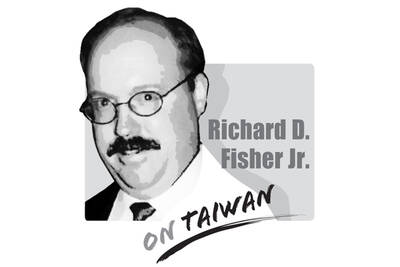Many people have high expectations of the presidential debates, especially candidates with lower support ratings, as they hope that the leading candidate will reveal flaws as she comes under fire and that her approval ratings will drop, providing them with an opportunity turn the situation around. By the same token, if the leading candidate does not stumble, she is likely to be victorious.
The first debate showed that the combined firepower of Chinese Nationalist Party (KMT) Chairman Eric Chu (朱立倫) and People First Party Chairman James Soong (宋楚瑜) was not enough to shake Democratic Progressive Party Chairperson Tsai Ing-wen (蔡英文). The debate did not turn the campaign around; it only consolidated the willingness of supporters to vote for their candidate, swaying perhaps only a minority of swing voters.
As the unchallenged leader in the polls, Tsai only has to maintain a middle-of-the-road stance. Chu attacked her for not recognizing the so-called “1992 consensus” and said that she has not explained what maintaining the “status quo” means because she simply has no answer.
Tsai counterattacked, saying that “you can never wake someone up who is pretending to be asleep” and that given this situation, she has been clear and consistent on the “1992 consensus” — namely that she “will respect public opinion and democratic mechanisms in order to promote cross-strait relations within the current Republic of China system.”
She also said that the results of cross-strait efforts over the past two decades would serve as the foundation for how her team would handle cross-strait ties.
Tsai also questioned Chu over a statement he made during his May visit to China: that the two sides of the Taiwan Strait belong to the same “one China.”
She also said that although he had strongly criticized President Ma Ying-jeou (馬英九) during the Sunflower movement last year and said the KMT would have to engage in some hard introspection, he has showed no such tendencies since becoming KMT chairman. Chu has simply been repeating Ma’s record of failure, she said.
Chu said things must not be taken out of context, and that the KMT’s position has never changed — that Taiwan should adhere to the “1992 consensus” and “one China, different interpretations.”
Soong said that cross-strait relations are a matter of being “pragmatic, pragmatic and pragmatic,” and that time should be used to create space for cooperation and mutual understanding, and to further expand exchanges.
Although Chu launched a forceful counterattack and Soong attacked from the flanks, Tsai was well prepared for questions about cross-strait relations and fired back. In the end, there were no winners or losers on this issue.
The difference between the presidential and the vice presidential candidates is that those seeking the nation’s top office are seasoned politicians who are supported by strong and experienced teams. They have prepared for all the possible questions and answers on every issue. Therefore, the debates can only show how carefully prepared they are.
The crucial factor in the debates is their empty accusations, lies and superficial promises. Remember how Ma offered pie-in-the-sky promises during the debates in the past two presidential elections. He has failed to deliver on almost every one of those promises during his almost eight years in office.
The debates are political shows and the best performer is likely to come out ahead. The debates should not be taken too seriously because a politician’s abilities and honesty are unlikely to be revealed.
On Sunday, 13 new urgent care centers (UCC) officially began operations across the six special municipalities. The purpose of the centers — which are open from 8am to midnight on Sundays and national holidays — is to reduce congestion in hospital emergency rooms, especially during the nine-day Lunar New Year holiday next year. It remains to be seen how effective these centers would be. For one, it is difficult for people to judge for themselves whether their condition warrants visiting a major hospital or a UCC — long-term public education and health promotions are necessary. Second, many emergency departments acknowledge

Victory in conflict requires mastery of two “balances”: First, the balance of power, and second, the balance of error, or making sure that you do not make the most mistakes, thus helping your enemy’s victory. The Chinese Communist Party (CCP) has made a decisive and potentially fatal error by making an enemy of the Jewish Nation, centered today in the State of Israel but historically one of the great civilizations extending back at least 3,000 years. Mind you, no Israeli leader has ever publicly declared that “China is our enemy,” but on October 28, 2025, self-described Chinese People’s Armed Police (PAP) propaganda
US President Donald Trump’s seemingly throwaway “Taiwan is Taiwan” statement has been appearing in headlines all over the media. Although it appears to have been made in passing, the comment nevertheless reveals something about Trump’s views and his understanding of Taiwan’s situation. In line with the Taiwan Relations Act, the US and Taiwan enjoy unofficial, but close economic, cultural and national defense ties. They lack official diplomatic relations, but maintain a partnership based on shared democratic values and strategic alignment. Excluding China, Taiwan maintains a level of diplomatic relations, official or otherwise, with many nations worldwide. It can be said that
Lockheed Martin on Tuesday responded to concerns over delayed shipments of F-16V Block 70 jets, saying it had added extra shifts on its production lines to accelerate progress. The Ministry of National Defense on Monday said that delivery of all 66 F-16V Block 70 jets — originally expected by the end of next year — would be pushed back due to production line relocations and global supply chain disruptions. Minister of National Defense Wellington Koo (顧立雄) said that Taiwan and the US are working to resolve the delays, adding that 50 of the aircraft are in production, with 10 scheduled for flight